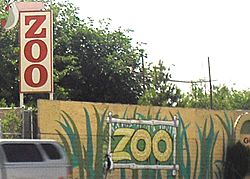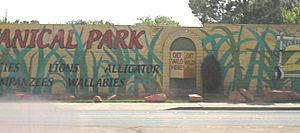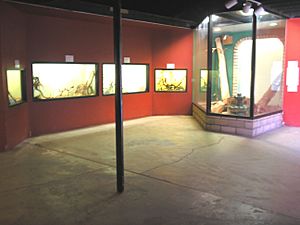Southern Nevada Zoological-Botanical Park facts for kids

Park exterior and sign
|
|
| Date opened | 1981 |
|---|---|
| Date closed | September 20, 2013 |
| Location | 1775 North Rancho Drive, Las Vegas, Nevada, United States |
| Land area | 3 acres (1.2 ha) |
| Coordinates | 36°11′32″N 115°11′23″W / 36.19217°N 115.1895905°W |
| No. of species | 150+ |
| Website | www.LasVegasZoo.com (Archived) |
The Southern Nevada Zoological-Botanical Park, also known as the Las Vegas Zoo, was a special place in Las Vegas, Nevada. It was a 3-acre (1.2 ha) zoo and botanical garden that was open from 1981 to September 20, 2013. The zoo was a nonprofit organization. It was located a short drive northwest of the famous Las Vegas Strip.
The main goal of the zoo was to teach people about desert animals and plants. It also aimed to protect their natural homes. The zoo wanted to "educate and entertain the public by displaying a variety of plants and animals." Visitors paid a small fee to enter. This fee, along with a gift shop, helped support the zoo's work. The park also had a small area where visitors could see different gems.
Contents
Starting the Las Vegas Zoo
Before this zoo, there was another one called the Las Vegas Valley Zoo. It opened in 1973 at Tule Springs Park. There were plans to move this zoo to a bigger, 255-acre area. This new zoo would have had 25 geodesic domes powered by the sun to house the animals. However, these plans never happened because of money problems.
The Southern Nevada Zoological-Botanical Park was started by a man named Pat Dingle (1947–2018). He was a veteran and a former police officer. Pat Dingle loved birds. In 1979, he opened a bird store. It was so successful that he retired from his police job in 1980. In 1981, he moved his bird store to the spot where the zoo would eventually be.
Experts from the San Diego Zoo noticed Pat Dingle's passion for birds. They encouraged him to create exhibits for rare and endangered species. This idea, along with the fact that Nevada didn't have a zoo, led him to open the Southern Nevada Zoological Park.
Zoo History and Growth
The zoo first opened in 1981. It started on a half-acre piece of land at 1775 North Rancho Drive in Las Vegas. To begin, Pat Dingle bought several animals for a petting zoo. These included a llama, goats, and sheep. His wife, Muffye, helped run the zoo with seven full-time zookeepers.
The zoo had an animal hospital on site. This hospital cared for the zoo's animals and was also open to the public. By 1986, the zoo was home to 50 animals and 150 birds. Some of these animals, like six Barbary apes and a dozen grivet monkeys, came from the San Diego Zoo. The Barbary apes were part of a special breeding program. About half of the zoo's animals came from private owners in the area. Pat Dingle once said that many people in Las Vegas had unique pets.
In 1989, the city helped the zoo with a loan of $157,000. In 1992, Pat Dingle shared plans for a much larger park called Deserts of the World Biopark. This new park would be built on 250 acres nearby. It would feature animals and even items from the Nevada Test Site. However, the new zoo was not built due to financial challenges. By 1993, the zoo had around 150 animals and 45 outdoor exhibits. Its yearly operating cost was about $250,000.
The zoo faced some challenges over the years. In 1993, an incident involving a Barbary ape led to public concern. The United States Department of Agriculture (USDA) looked into the matter. The zoo also had some financial difficulties, including issues with its city loan.
Despite these challenges, the zoo continued to attract visitors. In 1995, it had its highest number of visitors, with 53,173 people coming through its gates. In 1996, the zoo lost its 1.5-acre (0.61 ha) parking lot due to financial issues. However, the city lawsuit was settled in 1998. The zoo also received a donation of $15,000 from the San Diego Zoo in 2009 to help renovate an animal habitat.
The Las Vegas Zoo closed its doors permanently on September 20, 2013. The remaining staff members left, and the animals were moved to new homes. The vacant zoo building later caught fire in 2016 and was eventually taken down.
Animals at the Zoo
The zoo was home to more than 150 different kinds of plants and animals. It was especially known for having the last family of Barbary apes in the United States.
Here are some of the animals that lived at the zoo:
- Alligators
- Bali mynahs
- African lions
- Cougars
- Coyotes
- Eurasian lynx
- Fossas
- Golden eagles
- Chimpanzees
- Chilean flamingos
- Chinese alligators
- Eagles
- Emus
- North American river otters
- Ostriches
- Parrots
- King vultures
- Caracals from Turkmenistan
- Reptiles, including all types of venomous reptiles found in Southern Nevada
- Tigers
- Wallabies
Plant Displays
The zoo also had a botanical garden with various plants, including:
Images for kids
-
The zoo featured free roaming animals, such as this chicken
-
Peafowl, one of the free roaming animals at the park
See also
 In Spanish: Parque botánico y zoológico de Nevada Meridional para niños
In Spanish: Parque botánico y zoológico de Nevada Meridional para niños












